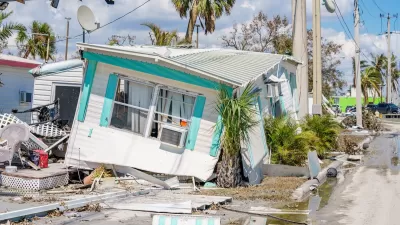NASA scientist James Hansen, considered to be the 'godfather of global warming' has co-authored a new report that shows the connection between 'extreme weather events', such as the drought most of the U.S. is now experiencing, and climate change.
In a report released on August 6 in the prestigious Proceedings of the National Academy of Sciences (PNAS), James E. Hansen, who directs the NASA Goddard Institute for Space Studies, makes the connection between what is termed 'extreme weather events', such as heat waves and droughts, and climate change.
In this video interview with the News Hour's Hari Sreenivasan, Hansen is asked, "....Explain how we know that these (extreme) events are ...not part of any natural cycle?"
"They are in fact a product of global warming and we can see that very easily", Hansen decisively answers.
In his August 3, Washington Post opinion, Climate change is here - and worse than we thought, Hansen makes the climate change-extreme weather connection clear.
"When I testified before the Senate in the hot summer of 1988, I warned of the kind of future that climate change would bring to us and our planet...My projections about increasing global temperature have been proved true.
Our analysis shows that it is no longer enough to say that global warming will increase the likelihood of extreme weather and to repeat the caveat that no individual weather event can be directly linked to climate change. To the contrary, our analysis shows that, for the extreme hot weather of the recent past, there is virtually no explanation other than climate change."
His view is not universally shared.
In his widely read "total turnaround" by climate skeptic, Richard Muller, states in his July 28, New York Times opinion, "The Conversion of a Climate-Change Skeptic, "...the recent warm spell in the United States happens to be more than offset by cooling elsewhere in the world, so its link to "global" warming is weaker than tenuous."
Hansen's paper may very well change the bar from discussing what the effects of global warming will be to what they are now.
FULL STORY: James Hansen: Extreme Heat Events Connected to Climate Change

Study: Maui’s Plan to Convert Vacation Rentals to Long-Term Housing Could Cause Nearly $1 Billion Economic Loss
The plan would reduce visitor accommodation by 25,% resulting in 1,900 jobs lost.

North Texas Transit Leaders Tout Benefits of TOD for Growing Region
At a summit focused on transit-oriented development, policymakers discussed how North Texas’ expanded light rail system can serve as a tool for economic growth.

Why Should We Subsidize Public Transportation?
Many public transit agencies face financial stress due to rising costs, declining fare revenue, and declining subsidies. Transit advocates must provide a strong business case for increasing public transit funding.

A Visual Celebration of Manhattan’s Chinatown Elder Community, Through Food
Lanterns, cafeteria trays, and community connection take center stage in this stunning photo essay.

How to Make US Trains Faster
Changes to boarding platforms and a switch to electric trains could improve U.S. passenger rail service without the added cost of high-speed rail.

Columbia’s Revitalized ‘Loop’ Is a Hub for Local Entrepreneurs
A focus on small businesses is helping a commercial corridor in Columbia, Missouri thrive.
Urban Design for Planners 1: Software Tools
This six-course series explores essential urban design concepts using open source software and equips planners with the tools they need to participate fully in the urban design process.
Planning for Universal Design
Learn the tools for implementing Universal Design in planning regulations.
City of Santa Clarita
Ascent Environmental
Institute for Housing and Urban Development Studies (IHS)
City of Grandview
Harvard GSD Executive Education
Toledo-Lucas County Plan Commissions
Salt Lake City
NYU Wagner Graduate School of Public Service





























